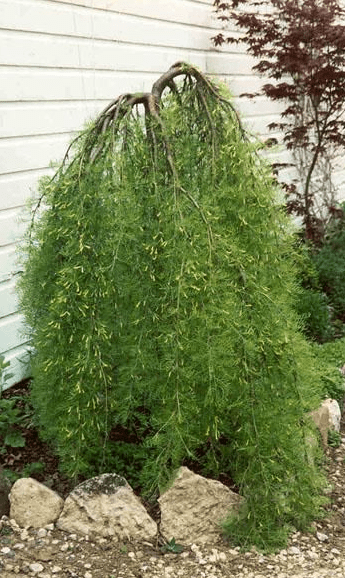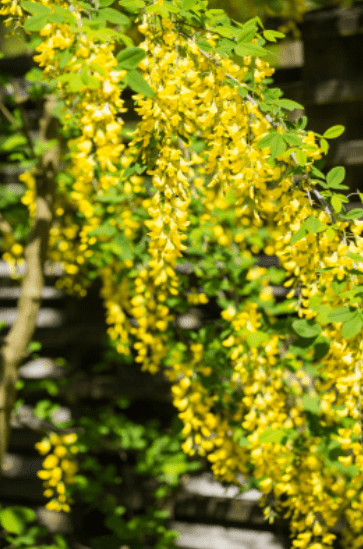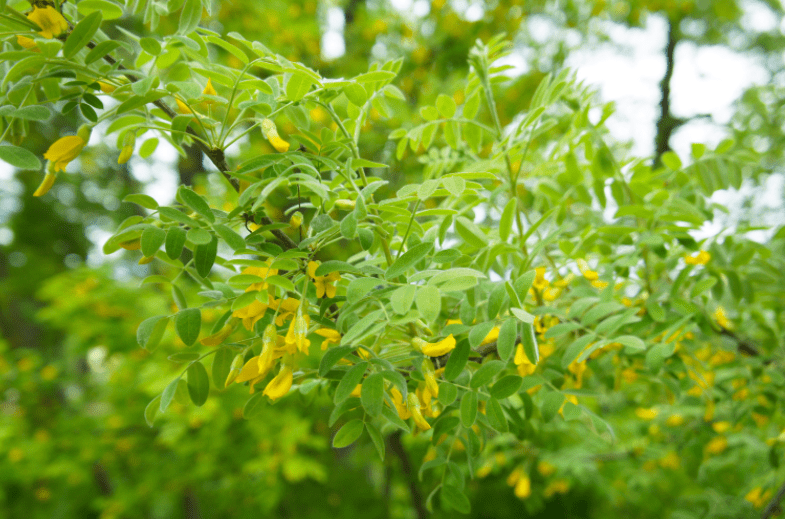Weeping Peatree And Caragana Pea Tree
Weeping peatree are those attractive deciduous trees with a four-foot straight trunk, then a mop of downward arching branches.
Once you understand that those downward-growing branches are grafted at the top of the straight trunk and that the trunk is grown separately from a regular fast-growing upright peatree, then you can see why any suckers from the base of that trunk or even sprouting anywhere below the graft, will quickly grow up through the mop. They can take over the tree, ruining the effect.
The downward-growing branches are grafted atop a meter-tall straight stem (from a regular peatree, or Caragana), so it never gets much taller than when you plant it.
The canopy forms a classic inverted mop shape, thickens, and eventually reaches the ground.
Maintenance pruning keeps the longer tips above the ground, removes dead branches, and keeps the canopy reasonably well-shaped, thinned, and controlled in size.
Watch for suckers, mainly at the base, which grow from the stem stock (below the graft), straight upward, not weeping. They will ruin the look of the tree and should always be pruned off.
How to Plant a Pea Tree
Caragana Pea trees are reasonably tolerant of most conditions; they can be planted in almost any region of the United States. Siberian pea trees can be grown in various conditions, including full sun, partial shade, and moist to dry soil.
Caragana pea trees can be planted in USDA plant hardiness zones 2-8 in clay, loam, or sandy soil media with high acidity or alkalinity.

Plant your pea tree after the risk of frost has passed in your area. Make a hole that is double the width of the root ball and 2 inches (5 cm) deep.
Add a couple of handfuls of compost and four handfuls of sand (if you have dense soil). Space each plant 5 to 10 feet (1.5-3 meters) apart if you want to make a hedge.
Fill the hole with 2 inches (5 cm.) of the amended soil, then add the new Siberian pea plant and the rest of the soil.
Thoroughly water the plant and tamp down the soil around it. Water every other day for the initial two weeks to establish strong roots, then reduce to twice a week for the following two weeks.
Pea Tree Maintenance
Because the Siberian pea plant is so adaptable, pea tree care is minimal once established.
Once the plant has begun to grow, feed it a slow-release fertilizer tablet or granules and water it in. You will only need to fertilize your lawn once a year, in the spring.
Unless the weather is boiling and dry, water once a week and prune as needed – ideally in late winter to early spring, especially if creating a hedge of Caragana pea trees.
Caragana pea trees can grow near the sea and in more arid climates, and they are immune to most pests and infections.
This hardy flowering specimen can live for 40 to 150 years, growing 3 feet (1 m.) per season, so if you plant Caragana in your landscape, you should enjoy the tree for many years to come.
Caragana Shooter
Plants, like people, can go ballistic without any provocation – and I mean “ballistic” in the literal sense.
Some plants are armed and, if not dangerous, at least intimidating because they can fire their seeds in the same way that a slingshot would fire a stone.
And, just as we use projectile weapons to fend off predators or hunt game, these plants use their ability to scatter seeds to ensure the survival of future generations.
Every August and September, I hear the crackle of caragana seedpods as they twist and fling their seeds across my back deck – sometimes the seeds travel as far as five meters if you consider the bounce and slide across my deck.
I’ve been “stricken” a couple of times myself, and while it’s not painful, I’d hate to be hit in the eye from close range!
So, as I sweep the deck before the first predicted snowfall this fall, I’ll still be cleaning caragana seeds out of the nooks and crannies.
Some plants scatter seeds in a “shotgun” fashion because they want to disperse their potential offspring far enough away so that they don’t compete with the mother plant when they reach maturity.
Typically, elastic contraction of the fruit causes the seed pod to split and eject its contents. As the pod grows, it twists into a coil, winding tighter and tighter, accumulating potential energy.
When the pods reach a certain level of maturity, they snap back into a more linear configuration, releasing all that pent-up energy and ejecting the seed.
Seedslingers
Caraganas are not the only plants that produce seeds. The West Indian sword bean holds the record for seed distance, blasting them six meters or so.
Hura crepitans, a common tree in the Euphorbiaceae family, is another explosive plant (the same family as the poinsettia). It’s also known as the dynamite tree because its pumpkin-shaped seed pods explode with a loud bang, scattering the seeds over a large area.
Closer to home, the herbaceous Oxalis corniculata is also known as yellow sorrel. When the flexible fruit-bearing capsule flips inside, this plant flings its seeds.
Impatiens, a popular annual in gardens across the country, are known as “touch-me-nots” because their seed pods burst when ripe.
The mature seedpods of the giant Himalayan impatiens, or Impatiens glandulifra, will roll inwards when touched, discharging seeds everywhere, as anyone who has grown this prolific plant can attest.
Proliferation
Because plants have inventive ways of dispersing seeds, controlling any unwanted seed shooters is difficult.
When designing your garden, understanding plant seed-dispersal mechanisms is to keep in mind; that a nice caragana bush can quickly dominate a yard if the seeds have a clear trajectory onto a bare patch of soil.
In my case, I’ve discovered caragana seeds growing on every patch of bare soil on the ground and caragana seedlings sprouting up in my planters.
I’ve even discovered seeds sprouting in the gaps between the boards on my deck. I make a point of removing caragana seedlings from my lawn and pots before they establish themselves.





























